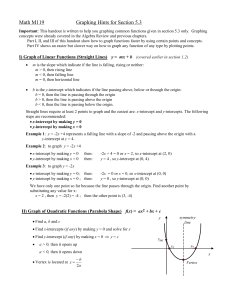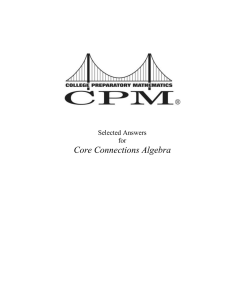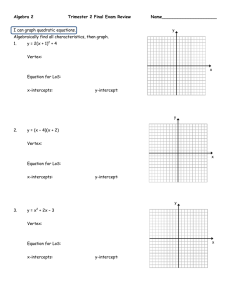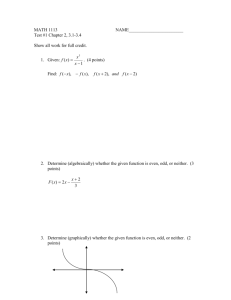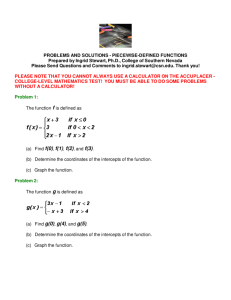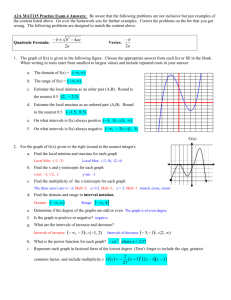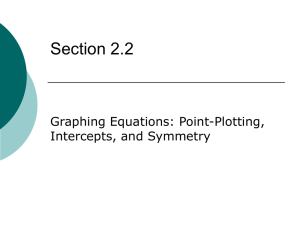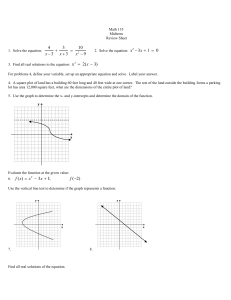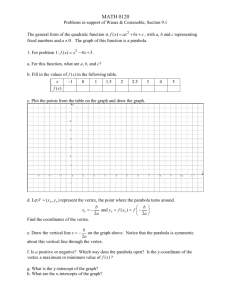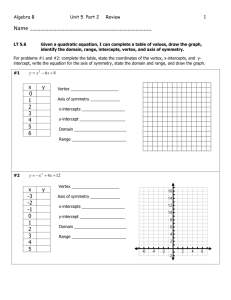File
advertisement
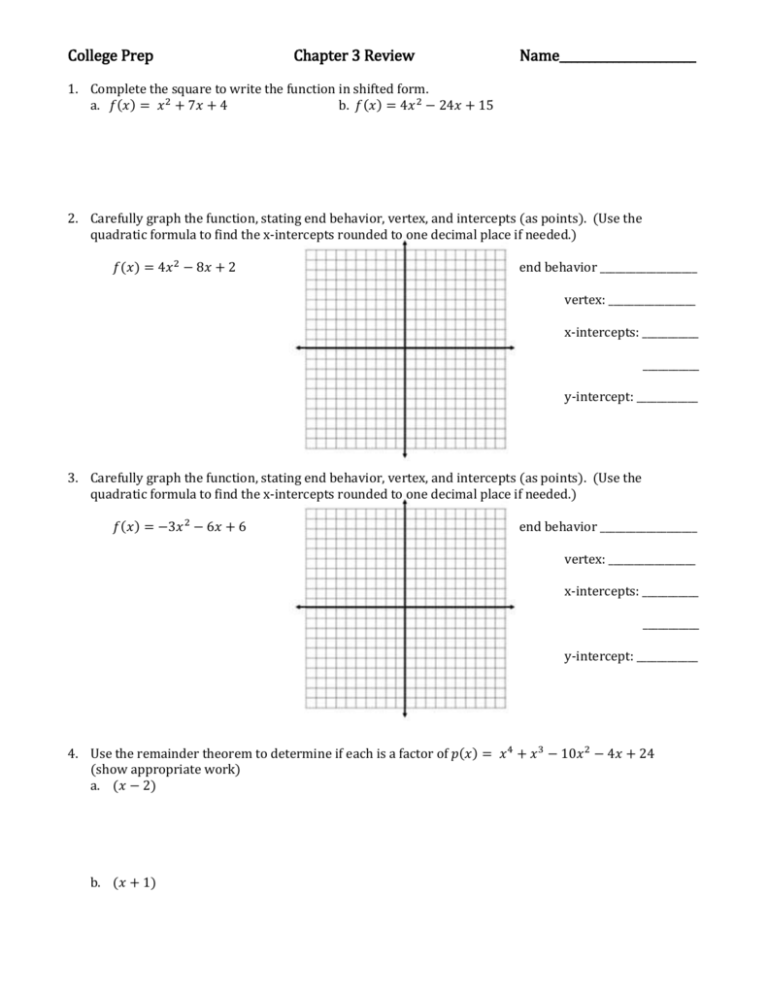
College Prep Chapter 3 Review Name_______________________ 1. Complete the square to write the function in shifted form. a. 𝑓(𝑥) = 𝑥 2 + 7𝑥 + 4 b. 𝑓(𝑥) = 4𝑥 2 − 24𝑥 + 15 2. Carefully graph the function, stating end behavior, vertex, and intercepts (as points). (Use the quadratic formula to find the x-intercepts rounded to one decimal place if needed.) 𝑓(𝑥) = 4𝑥 2 − 8𝑥 + 2 end behavior ___________________ vertex: _________________ x-intercepts: ___________ ___________ y-intercept: ____________ 3. Carefully graph the function, stating end behavior, vertex, and intercepts (as points). (Use the quadratic formula to find the x-intercepts rounded to one decimal place if needed.) 𝑓(𝑥) = −3𝑥 2 − 6𝑥 + 6 end behavior ___________________ vertex: _________________ x-intercepts: ___________ ___________ y-intercept: ____________ 4. Use the remainder theorem to determine if each is a factor of 𝑝(𝑥) = 𝑥 4 + 𝑥 3 − 10𝑥 2 − 4𝑥 + 24 (show appropriate work) a. (𝑥 − 2) b. (𝑥 + 1) 5. Find a cubic polynomial, 𝑝(𝑥), with real coefficients having roots 𝑥 = 3 and 𝑥 = −2𝑖. Assume a lead coefficient of 1. 6. Find a fourth degree polynomial, 𝑝(𝑥), with real coefficients having roots 𝑥 = −3, 𝑥 = 1 and 𝑥 = 4𝑖. Assume a lead coefficient of 1. 7. Use the rational roots theorem to list all possible rational roots of 3𝑥 4 + 14𝑥 3 − 𝑥 2 − 42𝑥 − 24 = 0 8. Use the rational roots theorem to write the function in factored form and find all zeroes. a. 𝑝(𝑥) = 𝑥 4 − 10𝑥 3 + 90𝑥 − 81 b. 4𝑥 4 − 15𝑥 3 + 9𝑥 2 + 16𝑥 − 12 9. State the degree, end behavior, and intercepts for the function. Indicate the graph’s behavior at each xintercept by circling b (bounce) or c (cross). a. 𝑓(𝑥) = (𝑥 − 1)5 (𝑥 + 7)(𝑥 + 2)2 degree ____________ end behavior ______ / ______ x-intercepts: ___________ ___________ ___________ b or c b or c b or c y-intercept: ____________ b. 𝑓(𝑥) = (𝑥 + 4)2 (𝑥 − 2)2 (𝑥 − 1) degree ____________ end behavior ______ / ______ x-intercepts: ___________ ___________ ___________ b or c b or c b or c y-intercept: ____________ 10. Carefully graph the polynomial. State end behavior and find all intercepts. a. 𝑓(𝑥) = 𝑥 3 − 2𝑥 2 − 11𝑥 + 12 end behavior: ________ / ________ x-intercepts: ____________________ ___________________ ___________________ y-intercept: _____________________ b. 𝑓(𝑥) = 𝑥 3 − 21𝑥 + 20 end behavior: ________ / ________ x-intercepts: ____________________ ___________________ ___________________ y-intercept: _____________________ 11. State the domain and range of the functions. 12. Determine the intercepts and asymptotes. 𝑓(𝑥) = 4𝑥 2 −16 𝑥 2 −36 y-intercept: ____________ x-intercepts: ___________ ___________ vertical asymptotes: ___________ ___________ horizontal asymptote: __________________ 13. Carefully graph the rational function. State the intercepts and asymptotes. 𝑥−4 𝑓(𝑥) = 𝑥+3 y-intercept: ____________ x-intercept: ___________ vertical asymptote: ___________ horizontal asymptote: __________________ 14. Determine the oblique asymptote. a. 𝑓(𝑥) = 𝑥 3 −𝑥 2 −9𝑥+9 𝑥2 b. 𝑓(𝑥) = 𝑥 2 +3𝑥+4 𝑥 15. If there is a removable discontinuity, repair the break by redefining the function using an appropriate piecewise-defined function. a. 𝑓(𝑥) = 𝑥 2 −2𝑥−3 𝑥+1 16. Solve the inequality using the graph. 𝑓(𝑥) ≤ 0 b. 𝑓(𝑥) = 𝑥 2 −9 𝑥+3 17. Solve the inequality by finding zeroes and testing intervals. 𝑥 2 + 4𝑥 − 5 < 0 18. Solve the inequality by finding zeroes and excluded values and testing intervals. Answer in interval notation. 𝑥2 − 9 ≥0 𝑥 2 − 12𝑥 + 11
